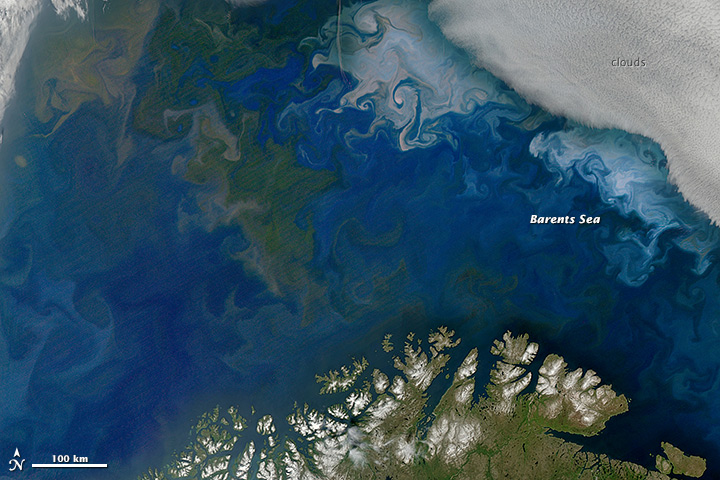 Photo linked from the Earth Observatory page (larger versions available there)
Photo linked from the Earth Observatory page (larger versions available there)
After recent observations of the greening of Silver Bay and the suggestion that the cause was a coccolithophore bloom, I was interested to see the photo above on NASA’s Earth Observatory page. This particular entry discusses an imaging showing two different kinds of plankton bloom in the Barents Sea. Apparently in that region it has been documented that diatom blooms peak in May, while coccolithophores peak in August. The diatoms favor well-mixed and relatively nutrient rich waters of late spring, while the coccolithophores compete well later in the year when surface water has warmed and the ocean overall becomes more stratified. If I’m understanding things correctly, the upper layer at that time also becomes less nutrient rich which favors the coccolithophores.
A couple of others informative articles were linked, What is a Coccolithophore gives a nice overview (note that it was written in 1999, so that’s the time frame when there is mention of ‘the past two years’). This article suggests that although they compete well in nutrient poor waters, they still provide suitable food for small fish and zooplankton that eat phytoplankton. Another article looks at large coccolithophore blooms in the Bering Sea during 1997 and 1998 which were thought to be unprecedented at the time. The article was also written in 1999, and while quite interesting, I wonder if there has been follow up work and/or if the blooms have continued in the intervening 15 years.
Of course the Barents and Bering Seas are much different than Silver Bay and the waters around Sitka, but assuming it is a coccolithophore bloom that’s causing the color change in Silver Bay (and other Sitka-area waters), it seems likely that it’s due to milder, relatively nutrient poor waters allowing them to out compete diatoms and other phytoplankton. This still doesn’t really answer the question of why this has apparently occurred only in the past couple of years (at least in recent memory). There was lots of sun last year, and lots of rain this year. That said, despite the rain this year, it has been consistently warm (for here), and perhaps that, plus a small snow pack (the runoff of which would be significantly colder than rain water) have contributed to warmer surface water this year, with extra sun driving it last. (Perhaps the folks out at Medvejie Hatchery track surface water temperatures in Silver Bay, and that data could be looked at?)
Questions:
- Is the late summer bloom a new normal, or an anomalous occurrence this summer and last?
- What oceanographic data (water column temperature profile, nutrient availability, etc.) is available for waters near Sitka?
- Are these sorts of blooms happening elsewhere in Southeast Alaska? Do they normally?